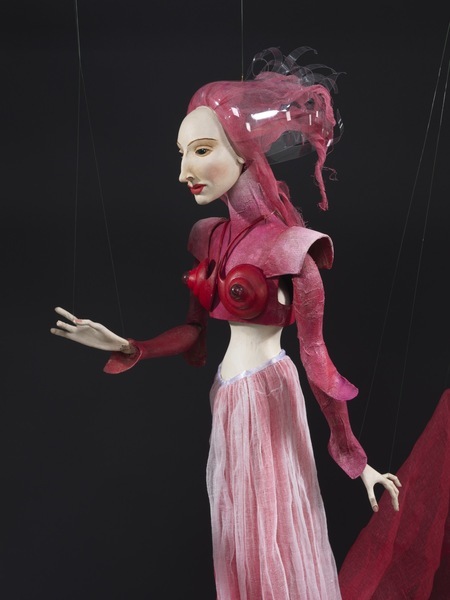Puppet Item Number: 3105/2 from the MOA: University of British Columbia


Description
String puppet (marioneta) representing the character Venus. Puppet wears a very long dark pink skirt, and a short dark pink top with plastic round nipples attached to the outside. Her hair is also pink; clear plastic points project from the back of her head. Her midriff is exposed, showing very pale 'skin', like her face. Her lips are painted dark red. Her eyes appear to be glass balls. Her hands are carved of wood. Artist's inscription at base of body.
History Of Use
Ten marionettes were made especially by Jorge Cerqueira for the Museum of Anthropology collection (see #2956/293-300 & #3105/1-2). These marionetas (string puppets) represent key characters—historical heroes and gods, sultans and kings, the dangerous storm, Adamastor, and the beautiful goddess, Venus, dressed in crimson—from the Portuguese epic, The Lusiads (1572). Written by the one-eyed adventurer and beloved poet, Luís de Camões, The Lusiads tells of the Portuguese discovery of a sea route to the East. The hero of the fantastical tale is the explorer, Vasco da Gama, who is either aided or opposed on his voyage by the Roman gods: Jupiter, Bacchus, Neptune and Venus. En route, Vasco da Gama’s fleet is welcomed by the Sultan of Malindi (Kenya) and bravely battles Adamastor, the gigantic storm, before arriving in India and meeting Monsayeed, the ruler of Calcutta (now Kolkata). Setting sail again, the Portuguese explorers stop to feast on the Isle of Love and afterwards journey on through the Indian Ocean, visiting parts of Asia and Africa. This character represents Venus, Roman goddess of love, beauty, fertility, and desire.
Iconographic Meaning
Puppet representing Venus, as a character in the epic "Os Lusíadas" (The Lusiads). Venus was the goddess of love, beauty, fertility, and desire in Roman mythology.
Item History
- Made by Jorge Cerqueira (Maker) in Sintra, Lisboa, Portugal during 2015
- Collected by Anthony A. Shelton during 2015
- Owned by Anthony A. Shelton before April 24, 2015
- Received from Anthony A. Shelton (Seller), Museum of Anthropology Acquisitions Budget (Funding source) and Museum of Anthropology Director's Budget (Funding source) on April 24, 2015
What
Who
- Culture
- Portuguese
- Creator
- Jorge Cerqueira (Maker)
- Field Collector
- Anthony A. Shelton
- Previous Owner
- Anthony A. Shelton
- Received from
- Anthony A. Shelton (Seller), Museum of Anthropology Acquisitions Budget (Funding source) and Museum of Anthropology Director's Budget (Funding source)
Where
- Holding Institution
- MOA: University of British Columbia
- Made in
- Sintra, Lisboa, Portugal
When
- Creation Date
- during 2015
- Collection Date
- during 2015
- Ownership Date
- before April 24, 2015
- Acquisition Date
- on April 24, 2015
Other
- Condition
- good
- Accession Number
- 3105/0002